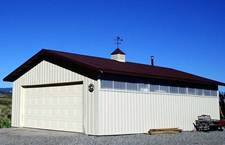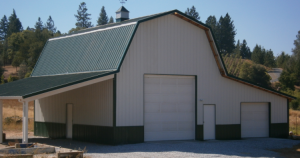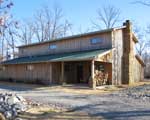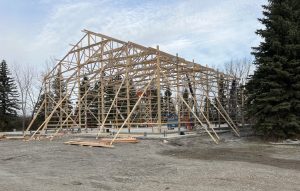One of our Building Designers, Alan, is a former general contractor who, prior to becoming a Building Designer, had constructed about 200 Hansen Buildings in several Pacific Northwest states.
This morning, he sent me an Instant Message as a client had asked if they, “could have eave lights in the roof of their building”?
Traditional “eave lights” were opaque fiberglass (actually fiberglass reinforced plastic) panels which have roughly the same rib configuration as the wall steel. Placed at the tops of the eave sidewalls, they would allow for affordable light transmission into the building.
The downside of fiberglass is the panels have a very low tolerance for UV rays from the sun. They quickly degrade, turning yellow and becoming brittle. This means they can crack and break. Besides the less than attractive “yellow” color, the amount of light transmitted through them decreases as the yellow color increases.
A better product exists – polycarbonate panels. Polycarbonates (with trademark names such as Lexan) are very durable and have high impact resistance. Polycarbonate eavelight panels have better light transmission characteristics than many kinds of glass.
Now pole buildings work like uni-body cars, the “skin” of the building transfers shear loads (from wind or earthquake) through the roof, to the endwalls and then down to the ground. When checking the design of the building, the “load path” needs to be checked to verify the clean transfer of forces at each material transition.
Steel roofing, like oriented strand board (osb) or plywood panels (when the correct product is properly installed) will allow for the horizontal transfer of shear loads. Polycarbonate eavelights or “skylight” panels, while able to withstand impacts and carry loads perpendicular to the surface, are not rated for carrying shear loads. Does this mean you can’t use them on roofs? Not exactly.
Polycarbonate panels can be used as “skylights”. However, depending upon the loads attempting to be transferred – the framing of the roof may need to be reinforced, and steel cross strapping added across the polycarbonate locations.
While not a big fan of putting “skylights” in roofs (they are a leak looking for a place to happen), I have seen some good applications, with careful installation including meticulous sealing. If you are set on having them, please at least consider hiring the installation out to someone who clearly has installed them before and you have reasonable expectation they “know what they are doing.”
The most affordable solution to add light through the roof is to use translucent ridge caps. The peak of the roof is the zero axis of shear loads on the roof – making this the ideal structural location. And this is something the average homeowner can install.
To receive more pole building tips and advice subscribe to the pole barn guru blog!











Do you have a how to video or page for DIY? I have a pole barn with 14′ side walls 56×36 and the eave lights will be on the east side of the building. I DO NOT want them in the roof. P.S. the Pole barn guru link does not work:-)
We have a Chapter in our Construction Manual which we can provide along with ordering the polycarbonate from us. We have precut 3′ tall panels (You would need 19) in stock. You will also need eave light flashing and 150 White screws. Please reach out to Materials@HansenPoleBuildings.com for price and availability.